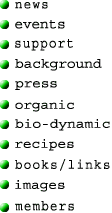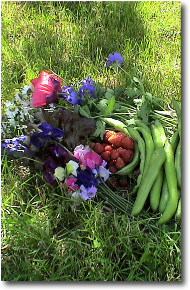


 This was a year of consolidation. We came and did our 2 hours and seem to be able to stay on top of things pretty well. We did not acquire any new allotments, as a matter of fact we changed things around a bit to make our work lighter.
This was a year of consolidation. We came and did our 2 hours and seem to be able to stay on top of things pretty well. We did not acquire any new allotments, as a matter of fact we changed things around a bit to make our work lighter.Allotment 1: One half was put down for main crop potatoes, it was very weedy. Dock and brambles tried to re-establish themselves. After the harvest of the potatoes, we concentrated on thoroughly digging these deep roots out, in preparation for the sowing of Rye and clover. The other half was allocated for cucumbers, sweetcorn and courgettes.
A large amount of manure was put in a strip where the courgettes were planted. The results were outstanding. The other produce was not that brilliant.
This allotment could do with a few years of laying fallow. We shall move our ‘recreational area’ from allotment 2 to allotment 1. It is nearer to the class room and flower beds. I have great hopes that it would look very pretty in the coming year.
Allotment 2: Has laid fallow for the last 4 years, so it is time to get it back into cultivation. Not everyone has been in favour of this decision as it has been a great place for children to run around and adults to relax, and it has been relatively easy to keep tidy, as I came once a week with the lawn mower to give it a cut. Rather than digging it over, we plan to carpet it over for the next year. The rye and clover that is currently there, will die down and we shall plant our pumpkins, squashes, cucumbers and courgettes through the carpets. This way it is very low maintenance
Allotment 3: This is divided into 2 parts. The left hand side and the right hand side.
This year the left hand side was planted up with new potatoes, leeks and brassicas.
We grew pentland javelin, as usual, but some people felt they were tasteless and fell apart whilst cooking. I shall look into another variety for the coming year. The leeks and brassica’s are looking good, although the cauliflower is small and spindly, I am not sure if this is worth growing this in our soil.
The right hand side however, has been tremendously productive. We have had a constant stream of different types of lettuces from March until October, the French beans in all colours, peas and mangetous were fantastic too. This is well worth repeating.
Allotment 4: New beds were made after last year’s pumpkins and root vegetables like: carrots, onions (red and ordinary ones), parsnips, beetroot grew very healthily.
On the side where we did not manage to dig this year, we carpeted it over and the children planted their ornamental gourds. They had a slow start but are now growing into the tree of the neighbouring allotment! A lovely little business they could set up to sell and raise money for the gardens.
Allotment 5: This strip has been carpeted over and pumpkins and squashes planted through. They have been very productive but we were disappointed with the lack of butternut squashes and turks turbans. We have some token specimens but not enough to share with the whole group. Unlike the other squashes, which we might even have to store for the winter.
Allotment 6: Last winter and early spring, we have moved raspberries and black and red currant bushes to this allotment. We now grow: Raspberries, strawberries, rhubarb, black currant, red currant, gooseberries, apples, pears, damsons, plums. The greengages, walnut, and peach trees were planted last year. They have all taken but no sight of fruit yet. All bushes are grown in beds to make the weekly awn mowing easier. This allotment has been easy to look after and looked good for most of the season.
Karina Wells, October 2005
Details of the crop rotation in all of the allotments can be viewed here

| home | news | events | support | background | press |
| organic | bio-dynamic | recipes | books/links | images | members |
Visit our online shopping centre with over 150 retailers |
|||||